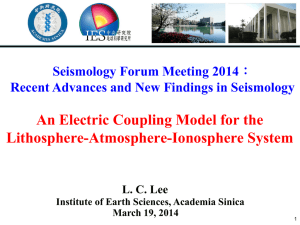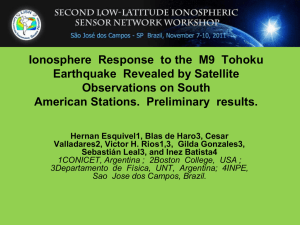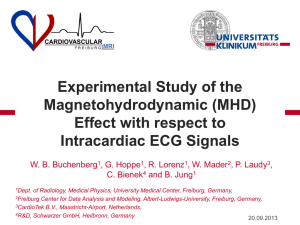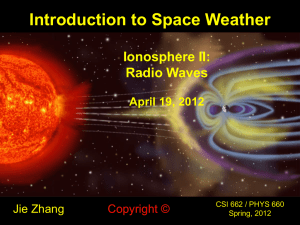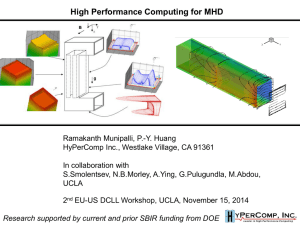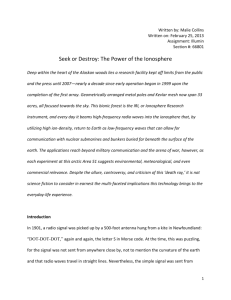Construction of the PPMLR
advertisement
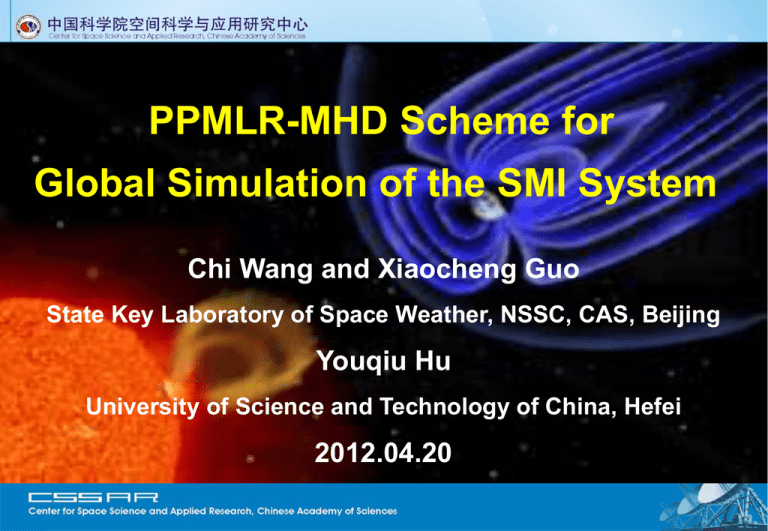
PPMLR-MHD Scheme for Global Simulation of the SMI System Chi Wang and Xiaocheng Guo State Key Laboratory of Space Weather, NSSC, CAS, Beijing Youqiu Hu University of Science and Technology of China, Hefei 2012.04.20 OUTLINES 1. Construction of the PPMLR-MHD Scheme 2. A Summary of Main Simulation Results 3. Prospects for the Future 1. Construction of the PPM-MHD Scheme Modelling of the SMI System (same as most models) Z Y Inner Boundary (r = 3 Re) SW Earth Sun X Global MHD for the solar windmagnetosphere (SM) system Electrostatical model for the ionosphere M-I coupling (1) The magnetospehere feeds the ionosphere with FAC (2) The ionosphere maps its electric field (EF) to the inner boundary of the magnetosphere Existing 3D Global MHD Simulation Codes Code Affiliation Reference Lax-Wendroff Nagoya Uni. Ogino et al. (1992) FV-TVD openGGCM Kyushu Uni. UCLA, UNH Tanaka (1994) Raeder (1995) GIMICS-3 Finnish Meteo. Inst. Janhunen (1996) LFM Dartmouth College Lyon et al. (1998) BATS-R-US Michigan Uni. Powell et al. (1999) PPMLR-MHD USTC, CSSAR Hu et al. (2005,2007) Difference Schemes of Conservational Type: Godunov Scheme Conserved quantities Ui are defined at the zone centers as volume averages, and their fluxes Fi1/2(Ui1/2) are defined at the zone interfaces as surface averages Ui1/2 are obtaned by an accurate or approximate Riemann solver, in which interpolations made among discret data determine the spatial accuracy of the scheme. 1. Godonov Scheme: step function, accuracy of 1st order 2. MUSCL Scheme: piecewise linear, accuracy of 2nd order 3. PPM Scheme: piecewise parabolic, accuracy of 3rd order A Distinguishing Feature of the PPM Scheme Schemes of the first-order accuracy: with strong numerical dissipation and poor resolution of MHD discontinuities and small-scale structures. Schemes of the second-order accuracy: with weak numerical dissipation but strong dispersion, and the latter demands additional artificial dissipation to stabilize the schemes, leading to a poor spatial resolution of the scheme, too. Schemes of the third-order accuracy like PPM Scheme: with weak numerical dissipation and weak dispersion, so the resultant scheme can operate stably with little or without additional artificial dissipation, leading to a higher spatial resolution of MHD discontinuities (~2 meshes) and small-scale structures. Construction of the PPMLR-MHD Scheme (1) To start from the MHD equations of conservational type in d t Lagrangian coordinates V 1 , v , r r0 0 vdt, (1) dt t dU 1 F S Sx S y Sz , (2) dt where U denotes the conserved quantities,F the fluxes, and S the source terms. (2) To separate them into 3 one-dimensional equations: dU 1 Fx dU 1 Fy dU 1 Fz Sx , Sy , S z , Lagrangian step(3) dt x dt y dt z U U U U U U Remapping step (4) vx 0, vy 0, vz 0, dt x dt y dt z t t t x x0 0 vx dt , y y0 0 v y dt , z z0 0 vz dt , (for coordinate mapping) (5) and to sweep along 3 coordinates alternatively: first x, y, z, followed by z, y, x. Construction of the PPMLR-MHD scheme (cont.) (3) To execute Lagrangian step and to remap to Eulerian grid Taking x-direction as an example: dt F F 1 1 xi , jk xi , jk Lagnrangian step: (1) (0) U ijk U ijk 2 2 ijk xi 1 xi 1 2 2 dtS xijk , (5) where F xi1/2,jk F(Ui1/2,jk) and Ui1/2,jk is defined at the zone interface, evaluated by an approximate Riemann Solver in terms of PPM-TVD (Total Variation Diminshing) interpolation. Remapping to the Eulerian grid (Convection step) v xijk t (1) ( 2) (1) U ijk U ijk (U i 1 / 2, jk U i(11)/ 2, jk ), xi where U (1) are determined by PPM-TVD interpolation, too. i 1 / 2, jk A similar treatment is made along y- and z-directions. (6) Construction of the PPMLR-MHD scheme (cont.) (4) Artificial Dissipation Taking x-direction as an example, the Euler grid interface coordinates xj+1/2 are shifted globally by x j 1 / 2 x j 1 / 2 K , where 0 K < 1, and “+” for odd steps, “” for even steps, and is the minimum spatial step length. It stands for a convection followed by a reverse one, resulting in an artificial dissipation, whose strength depends on the magnitude of K . For ordinary schemes of 2nd accuracy, K =1 for stabilizing the scheme For PPM scheme, taking K = 0.1 is enough, so that the numerical dissipation is about tenth of that for ordinary schemes. One may reduce K below 0.1 so as to further decrease the dissipation For instance, we took K = 0 for due north IMF cases to reproduce K-H waves at magnetopause and standing shocks in the magnetosheath, and K = 0.0001 for due south IMF cases to reproduce standing shocks in the magnetosheath. Sweeping in proper order along 3 axes Flow Chart of the PPMLR-MHD Scheme Magnetospheric MHD X-sweeping Lagrangian step Y-sweeping Ionospheric Electrostatics Mapping FAC to ionosphere Z-sweeping Remapping to the Fixed Eulerian grid Solving for ionospheric potential Mapping EF to magnetosphere OUTLINES 1. Construction of the PPMLR-MHD Scheme 2. A Summary of Main Simulation Results 3. Prospects for the Future 2. A Summary of Main Simulation Results I. Response of Magnetic Field at the Synchronous Orbit to IP Shocks (Wang et al., 2000) Simulation of a negative response of the magnetospheric magnetic field at night side to IP shocks Positive response Negative response Physical Explanation Flows caused by IP shocks near the flanks Develop toward the x axis Diverge at the x axis earthward flow formation Decrease of Bz II. Large-Scale Electric Current System in the Magnetosphere and Ionosphere (Tang et al., 2009) For the case of IMF BZ = 0, a classical -shaped structure is well reproduced by simulations For cases with south IMF BZ , part of the cross-tail current is closed via the bow shock, forming a double -shaped structure X = -15Re IMF Bz = -5 nT ( Tang et al. JGR, 2009) III. Intensification of the Cowling Electrojet via Magnetosphere-Ionosphere Coupling (Tang et al., 2011) Given a south turning of the IMF, the Perdersen and Hall conductances are increased artificially from 5S to 25S and 60S, respectively, in 10 minutes after the NEXL is formed. The enhancement of ionospehric conductances leads to intensification of the Cowling electrojet in the ionosphere IV. K-H Waves at the Magnetopause under Due North IMF Cases (Guo et al., 2010) Previous studies of K-H waves were limited to local analyses The PPMLR-MHD code reproduces the global structure of the K-H waves across the magnetopause Contours of Vx in the equatorial plane, showing vortex structures of the K-H waves at the magnetopause OUTLINES 1. Construction of the PPMLR-MHD Scheme 2. A Summary of Main Simulation Results 3. Prospects for the Future 3. Prospects for the Future Global simulations aimed at substorms by diagnozing The role of M-I coupling in the formation of electrojets, NEXL, and dipolarization of the magnetospheric magnetic field The propagation and reflection of Alfvén waves between the magnetotail and the ionosphere Extending these diagonoses from quasi-steady to time-dependent regime Conbine simulations with ground-based geomagnetic field and ionospheric observations in order to closely coordinate with the Meridional Chain Program Equivalent current system in the ionosphere Auroral patterns and their temporal evolution in the ionosphere Magnetic field and particle observations at the synchronous orbit High spatial resolution simulations of middle- and small-scale structures of the magnetopshere, such as K-H waves, FTE events, BBF events, magnetotail current sheet, and their fine configuration, mechanism of formation, and temporal evolution. Thank You!

